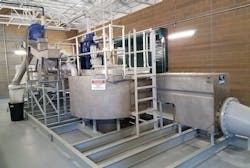New Lakeside Headworks Package at Morgan City
Lakeside Equipment, www.lakeside-equipment.com, 630.837.5640
In Morgan City, Utah, the need to upgrade the wastewater treatment plant’s lagoons became a priority when the system went septic. The city was looking at designs for mechanical treatment systems prior to a dredging operation that removed more than 7 million gal of sludge from the laden lagoons.
“We needed to comply with existing regulations, but we also wanted to accommodate anticipated growth,” said Jamie Grandpre, Morgan City senior water and wastewater operator. “This included compliance with the Phosphorus Rule, which was enacted by Utah Division of Water Quality in 2015.”
The Phosphorus Rule implements technology-based phosphorus effluent limits for mechanical treatment facilities (total phosphorus less than 1 mg/L) and a nutrient load cap for discharging lagoons.
“We anticipate that our lagoons will exceed their phosphorus load in approximately five years, so when we were weighing up the options for mechanical treatment systems, we decided to work with J-U-B Engineers to move forward with a phased solution,” Grandpre said.
As well as helping the lagoons maintain compliance for its permit, the city also would be prepared for a future Phase 2 nutrient removal project. All improvements implemented in Phase 1 are to set to be utilized in Phase 2.
“We agreed that we needed a long-lasting mechanical fine screen and grit removal system, so [we] joined forces in doing our homework and visiting other wastewater treatment facilities in Utah to speak to operators,” said Gary Vance, J-U-B project engineer.
The city selected a stainless-steel, corrosion-resistant, complete headworks package from Lakeside Equipment Corp. via its representative in Utah, Goble Sampson. This compact Headworks Packaged System combines the Lakeside 6 mm Raptor fine screen with a bypass bar rack, plus the SpiraGrit vortex grit chamber in an elevated pre-engineered headworks system. The system came with tanks for screen and grit removal, as well as platforms and a trough to connect them. The headworks also were designed to accommodate a peak hour flow of 4 million gal per day, which exceeds the anticipated 20-year peak hour flow rate of 2 mgd.
Since installation, the fine screen has removed inorganic solids that would otherwise head to the lagoons. Its efficiency and low head-loss is achieved with an inclined cylindrical screening basket with varied screen bar heights. The rotating rake teeth penetrate the screen bars to remove captured debris and prevent grease from blinding or plugging the basket.
“Collecting all the garbage and grit before it goes to the lagoons has made them so much cleaner. We now have more capacity, whereas before you could see the build-up of scum in the corners,” Grandpre said. “Locally, we have an industrial park with some small-scale manufacturing, but immediately after the Lakeside installation, we couldn’t believe how much grit was being collected that previously would have gone into our lagoons. Now with such a strong and reliable screen and grit removal system, the negative impact on the plant has been solved.”
